William T. Poague facts for kids
Quick facts for kids
William T. Poague
|
|
|---|---|
 |
|
| Born | December 20, 1835 Rockbridge County, Virginia |
| Died | September 8, 1914 (aged 78) Lexington, Virginia |
| Buried |
Oak Grove Cemetery
Lexington, Virginia |
| Allegiance | |
| Service/ |
|
| Years of service | 1861–1865 |
| Rank | |
| Battles/wars | In the American Civil War: |
| Other work |
|
William Thomas Poague (born December 20, 1835, died September 8, 1914) was an important officer in the Confederate Army during the American Civil War. He was part of the Artillery, which means he commanded cannons. After the war, he became the Treasurer for the Virginia Military Institute.
Contents
Early Life and Education
William T. Poague was born in Rockbridge County, Virginia. His parents were John Barclay and Elizabeth Stuart Paxton Poague. He went to Washington College and was part of a group called Phi Kappa Psi. Before the Civil War started, he was working as a lawyer in St. Joseph, Missouri.
Service in the Civil War
When the Civil War began, Poague returned to Virginia. He joined the Confederate Army as a second lieutenant in a famous unit called the Rockbridge Virginia Artillery. This unit was known for its cannons.
Rising Through the Ranks
By April 1862, Poague was promoted to captain of his unit. He fought in many important battles with his artillery battery, including:
- First Manassas
- Romney
- Kernstown
- McDowell
Later, he joined the Army of Northern Virginia and took part in battles like:
- The Seven Days Battles
- Battle of Cedar Mountain
- Second Manassas
- Harper's Ferry
- Antietam
- Battle of Fredericksburg
On March 2, 1863, Poague was promoted again, this time to major. He worked as an executive officer for David G. McIntosh at the Battle of Chancellorsville. After that, he was given command of his own group of artillery units, called a battalion.
Key Battles and Actions
Major Poague led his battalion in several major battles, including:
- Battle of Gettysburg
- Battle of Bristoe Station
- Battle of Mine Run
- Wilderness
- Spotsylvania
- North Anna
- Cold Harbor
One of his most important moments was during the Battle of the Wilderness. His artillery battalion helped stop a strong attack from the Union Army's II Corps. They fired their cannons over the heads of wounded Confederate soldiers to hold the line. This gave time for General James Longstreet's troops to arrive and help. General A. P. Hill even helped load Poague's cannons because the situation was so desperate. Poague was wounded twice at the Battle of Cold Harbor. He later helped defend Petersburg and finally surrendered at the Battle of Appomattox Court House, which ended the war.
After the War
After the Civil War ended, William Poague had a busy career. He worked as a farmer, a teacher, and a lawyer. He also became involved in politics, representing Rockbridge County in the Virginia House of Delegates.
He served on the Board of Trustees for Washington College (which later became Washington and Lee University) from 1865 to 1885. From 1884 until his death on September 8, 1914, he was the Treasurer of the Virginia Military Institute (VMI). He also served as Secretary for VMI's Board of Visitors.
Poague wrote a book about his experiences during the war called Gunner With Stonewall. His personal papers and writings are kept at VMI. William T. Poague is buried at Oak Grove Cemetery in Lexington, Virginia.


